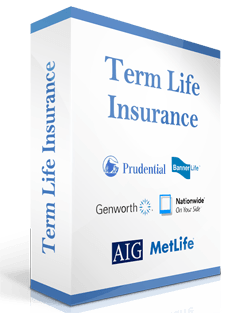
Term life insurance is a life insurance product that is designed to help you protect your financial responsibilities temporarily in the case that you pass away. Most of our clients are a perfect fit for a term life insurance policy since it can cost less than a can a coke per day but provide a substantial amount of life insurance. Over the year’s term life insurance has been growing in popularity due to its simplicity and affordability, which is a perfect fit for the modern day consumer. So is term life insurance a good product? Let’s find out and go over the pros and cons of term life insurance.
In summary, here is a quick breakdown of the pros and cons:
Pros
- Affordability- the cost of term life insurance is the absolute lowest compared to other life insurance products, hey maybe even other insurances too. It’s not unlikely for the client to pay from $15 to $30 per month for a $500,000 life insurance policy.
- Simplicity- term life is a very easy to understand coverage since it doesn’t come with many bells and whistles. Pay this much a month and you’re covered for this much coverage, nothing more and nothing less. Ohh, and did we forget to mention that in most cases you can apply and get approved immediately when applying for a no exam plan.
- Convertible- You may be thinking of a drop top car but we are referring to the fact that the term life insurance policy can turn into a whole life or universal life insurance policy without any new underwriting.
Cons
- Expiration- like all great things term life insurance policy is only good for the length of time you buy for, typically 10, 20 or 30 years. After that, it turns into an annual renewable term which costs an arm and a leg, plus goes up every year.
- Lack of Cash Value- there is no savings element with term life insurance as there is a whole life insurance policy. Which is kinda of good since you’re not paying a Lexus payment equivalent for life insurance.
Term Life Insurance Pros
Term life insurance has more Pros than Cons. It’s hands down the most affordable and simple life insurance products on the market, along with many add-ons that make it highly customizable. Let’s get into the detail of each upside.
Affordability
In comparison to any permanent life insurance product term life insurance is more than half as affordable as the cheapest permanent policy. It’s a great option for those who either can’t afford or don’t have a need for lifetime coverage. If your biggest concern is replacing your income, your 20-year mortgage, and your kids’ college tuition, then a 20-year term life insurance policy would probably be able to take care of it all for a very affordable rate. How affordable? Well, let’s say you’re a 35- year old male who makes $40,000 a year, has $120,000 left on his mortgage and has 2 kids who are 5 and 8. If something were to happen to you, you would want to leave your spouse with a replacement of your income for at least 10 years so what would that cost us?
In this situation, we would assume we need about $600,000 for 20 years. The best rate comes in for $26 dollars a month(based on perfect health). If we run the same quote for a permanent No Lapse GUL policy it would be $222 dollar per month. That’s not including a quote for a whole life policy, which tends to be up to 3 times as expensive as a No Lapse Guaranteed UL.
Term life is actually our recommended product for young families since you can get a lot of coverage for a lower monthly premium during the most vital years. After the mortgage is paid off and the kids are off to college the need for life insurance diminishes greatly.
According to TrueBlueLifeInsurance: “These types of policies are great options for people who have a limited budget and can’t afford whole life type policies or for those looking to have additional coverage to protect loved ones from the financial impact of their death.”
Simplicity
One of the biggest reasons for its popularity is its simplicity. Most permanent life insurance policies come with a cash value accumulation aspect, which isn’t awfully complicated if explained properly, but it tends to throw consumers off. This is because when most young couples shop for life insurance they’re looking for pure death protection, most aren’t interested in overpaying for an investment portion of the life insurance. Term life insurance is as simple as you pay a premium for a set amount of years, and if something happens to you within that time frame, your family will receive a set amount of money. Most beneficiaries can collect on the claim within 10 business days by simply reaching out to the insurer or the insurance agent.
Convertible on a Guaranteed Basis
Unless you’re an agent or have dabbled in life insurance somehow, then that probably doesn’t mean much to you, so let me explain one of the best pros of a good term life insurance policy. Most people consider term life insurance expiring as one of it’s biggest cons, however, there is a decent fix to this. Term life insurance policies come with an option to convert the policy to a permanent one at the time of expiration, or old age, whichever comes first. The best part is this happens on a guaranteed basis. This means that you will not have to prove to be insurable at the time of the conversion. So if you were to get a serious illness during the term period, even though you were healthy at inception, you would still be able to convert with your previous health rating status. The only change in your premium would be adjusted for your age, which can cause quite an increase. The fix to this is to lower the coverage amount to your new, hopefully, lesser need for life insurance.
As mentioned before if you’re a younger individual who just got a mortgage and have two young kids, you’d wanna protect them by securing let’s say a $1 million dollar life insurance policy. However, once the debt like a mortgage is paid off and your kids have their own foundation so you can convert the term from $1 million to let’s say $200,000 of permanent life insurance to cover final expenses regardless of your health.
Term Life Insurance Cons
While the cons are few, term life insurance, like most things, isn’t perfect. Let’s cover the few cons.
Expiration Date
While it may be convertible it doesn’t change the fact that term life insurance does carry an expiration date. This means that at the end of the term one of two things will happen: either you will no longer have coverage, or your premium will shoot up. To avoid this it can be a good idea to get a term policy for your temporary needs a permanent policy for more permanent life insurance needs like covering final expenses. Most term policies are good for a period of 10, 15, 20 or 30-year term lengths.
No Cash Value
Term life insurance policies do not carry a cash value accumulation that permanent policies have with them. Now while I personally don’t recommend life insurance as an investment, the cash value can be used for more than that. Permanent policies like No Lapse Universal Life often use the cash value to keep the levels premium or offer benefits like a longer grace period before the policies lapses when you forget a payment. However, if you get a return of premium term life insurance policy it does have a savings element since the idea is to get all your payments back at the end of the term if you didn’t use the policy. These policies are very expensive and sometimes don’t make sense financially.
Is Term Life Insurance Right for You?
The best way to determine that is to weigh your need for life insurance. This is preferably done with an agent, sit down and gauge your needs for life insurance and find out whether they’re more permanent or temporary. A great place to start is also what you can afford. Sometimes it makes sense to layer two different types of policies to lock in good rates at a young age and good health. The good news is you’re at the right place.
Generally speaking, if you need a large amount of coverage but can’t spend too much on it then a term policy will be ideal. Also, if your coverage needs are temporary like mortgage protection or covering kids while they are dependents that are also a sure sign to get a term life insurance policy. For most young families or individuals under age 50, a term life insurance policy will be an ideal choice based on our experience. After age 50 most people tend to be more concerned about leaving their families without the burden of funeral expenses or leaving a little extra money for their loved ones, which is when we recommend a permanent life insurance option like a whole life or universal life policy locked in until age 100.
Additional Benefit of Term Life Insurance
Many individuals don’t know that most large carriers offer their term life plans with some customizations known as riders. There are many riders like child rider, waiver of premium, return of premium and accelerated death benefit rider. We are going to focus on the accelerated death benefit rider because it is built into most term life insurance plans at no extra cost. For more information on riders available read our article on it. Accelerated death benefit rider allows you to get up to 50% or higher of your death benefit up front if you have a terminal illness with 12 months or less of live expectancy. This is a great option since it will allow you to use your life insurance while you’re still living in the event you had cancer.
Getting Started
The best place to start is to compare quotes online and see what makes the most sense for you financially. To determine how much coverage you need use our needs calculator and then hop over to the quote engine to compare rates with over 60 A-rated companies on the market. The general rule of thumb is to get 10x to 15x times your annual income as an adequate amount of life insurance coverage. As far as the lenght of the coverage always go by getting to your retirement age, completion of your mortgage or your youngest child turning 25 year of age. If you have any questions feel free to call us, chat us, or drop a comment below. Welcome to InsureChance!






